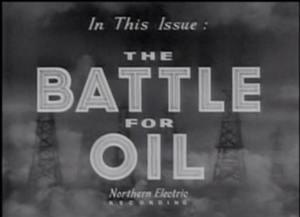The Battle for Oil facts for kids
Quick facts for kids The Battle for Oil |
|
|---|---|

Title Frame
|
|
| Directed by | Stuart Legg |
| Produced by | Raymond Spottiswoode |
| Narrated by | Lorne Greene |
| Music by | Lucio Agostini |
| Cinematography |
|
| Editing by | Stuart Legg |
| Studio | National Film Board of Canada |
| Distributed by | Columbia Pictures of Canada |
| Release date(s) | September 1942 |
| Running time | 19 minutes |
| Country | Canada |
| Language | English |
The Battle for Oil is a 1942 Canadian documentary film. It's also known as Battle for Oil. This 19-minute movie was made by the National Film Board of Canada (NFB). It was part of their Canada Carries On series during World War II.
The film was produced by Raymond Spottiswoode. Stuart Legg directed it. The Battle for Oil explains why oil was so important in modern warfare. The French version of the film was called La Bataille du pétrole.
Why Oil Was Important in World War II
During World War II, oil was like the lifeblood for armies. It powered tanks, planes, ships, and trucks. Without enough oil, armies couldn't move or fight. This film shows how important oil was for both sides in the war.
Oil for the Allies
In 1942, people at home in North America had to make sacrifices. They needed to help the war effort. One big change was using less gasoline and lubricants. This meant people couldn't drive their cars as much.
These wartime rules helped the Allies save a very important material: oil. Oil came from huge oilfields in places like Texas, Mexico, Venezuela, and the Caribbean. This oil fueled the Allied war machine.
Soldiers were sent to protect these vital oil sources. Royal Navy warships sailed far out to sea. They protected convoys of ships carrying oil. These convoys were crucial for the Allied cause. But they relied heavily on oil reserves around the world.
Oil for the Axis Powers
The Nazi war machine also needed oil. Germany didn't have many natural oil supplies. So, they had to make expensive fake fuels. They had 25 factories working non-stop to produce it.
These factories were often attacked by the Royal Air Force. In distant battlefields, oil was a major prize. Nazi armies threatened the rich oilfields of Baku. The Soviet Union fought hard to keep this region. The German leaders knew their army, the Wehrmacht, could stop if they didn't get oil.
In the Middle East, the world's largest oil deposits are found. Other oil wells and refineries there were also in danger. The Axis powers were advancing. Pipelines to Haifa and Tripoli were targets. Storage tanks in Palestine, guarded by British and Soviet forces, were constantly bombed.
In the Far East, Japan also depended on foreign oil. They were moving quickly towards oil reserves in the Dutch East Indies and India. Singapore became a strong fortress. The British Empire relied on it to face the coming Japanese attacks.
Oil Fuels the Fight
As the Allies began to attack, oil was still key. When the German battleship Bismarck tried to escape, British battleships and destroyers chased it down. These ships ran on oil.
Nightly Royal Air Force air raids also started to work. But for every bombing trip to Berlin, a huge amount of fuel was needed. Each heavy bomber used 3,800 tons of high-test fuel.
Global oil production kept going. A new discovery was made in the Turner Valley oilfields in Alberta, Canada. This new field became very important. It produced one-sixth of all the oil in Canada.
The Portland–Montreal Pipeline was built. It brought oil from Portland, Maine to refineries in Montreal. From there, large oil tankers sailed off in escorted convoys. They had to dodge dangerous German U-boats. Their mission was to deliver precious oil to the battlefront in Europe.
How the Film Was Made
The Battle for Oil was a typical film from the NFB's Canada Carries On series. These were propaganda films. They aimed to boost people's spirits during the war. The films were made with help from the Director of Public Information.
The movie was a compilation documentary. This means it used lots of existing footage. Stuart Legg edited the film to tell a clear story. It used many newsreel clips, even some from the "enemy." These clips helped create the background for the narration. An NFB film crew also went to the Turner Valley oilfields in Canada to film.
The deep voice of actor Lorne Greene narrated The Battle for Oil. Greene was famous for his radio work. He was a news announcer at the CBC. He also narrated many films in the Canada Carries On series. His powerful voice earned him the nickname "The Voice of Canada." Some even called him the "voice-of-God." When he read serious news or battle facts, he was known as "The Voice of Doom."

